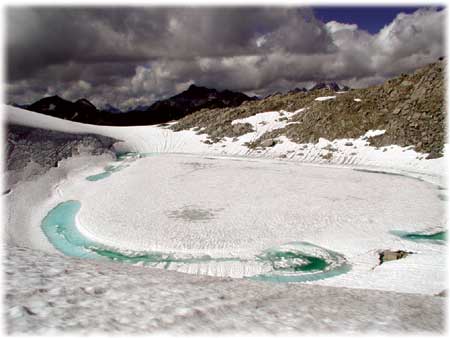

Wiley Lake, North Cascades National Park
|
GLACIER MONITORING
Glaciers Mirror Global Climate
Change
The North Cascades ecosystem has the
highest concentration of glaciers in the lower 48 states. Studying
climate response and changes in glaciers can help predict future climate
changes. Since they are important to the health of the region and
sensitive to fluctuations in climate, monitoring their status is a
priority.
Over 700 of these slow moving giants, formed
of rock and ice, play a critical role in natural processes and life of
the entire region. At Thunder Creek in North Cascades National Park,
glaciers contribute as much as 47% to total summer runoff.
The National Park Service began monitoring
glaciers in North Cascades National Park in 1993 and in Mount Rainier
National Park in 2002. The partnership between parks and the United
States Geological Survey, which also monitors glacial trends, allows
data to shed light on the global implications of climate
change.
In North Cascades National Park, researchers
Jon Riedel and Rob Burrows lead the monitoring of four glaciers that are
at the headwaters of watersheds containing hydroelectric operations.
Silver Glacier, which drains into Ross Lake, and Sandalee Glacier, which
drains into the Bridge Creek watershed, are both east of the park's
hydrologic crest. Noisy Creek Glacier, which drains into Baker Lake, and
North Klawatti Glacier, which drains into the Thunder Creek watershed,
are both on the west-side.
To gauge the dynamics of these glaciers,
researchers use stakes to measure snow accumulation, radar to estimate
thickness and aerial photos to study boundaries. Mass balances are the
net amount of gain or loss glaciers experience each year. Current
findings show a varied trend toward diminishing glacial mass balances.
Glaciers east of the crest have not shrunk as quickly as their west-side
counterparts in the first decade of study. Reasons for the differences
might include higher elevations and more northerly aspects of the
east-side glaciers.
Besides telling us about the health of these
glaciers, the studies show how glacial runoff contributes to watersheds
and regional ecology. This year, a 10-year data summary will be
published on this ongoing research.
www.nps.gov/noca/massbalance.htm
|
